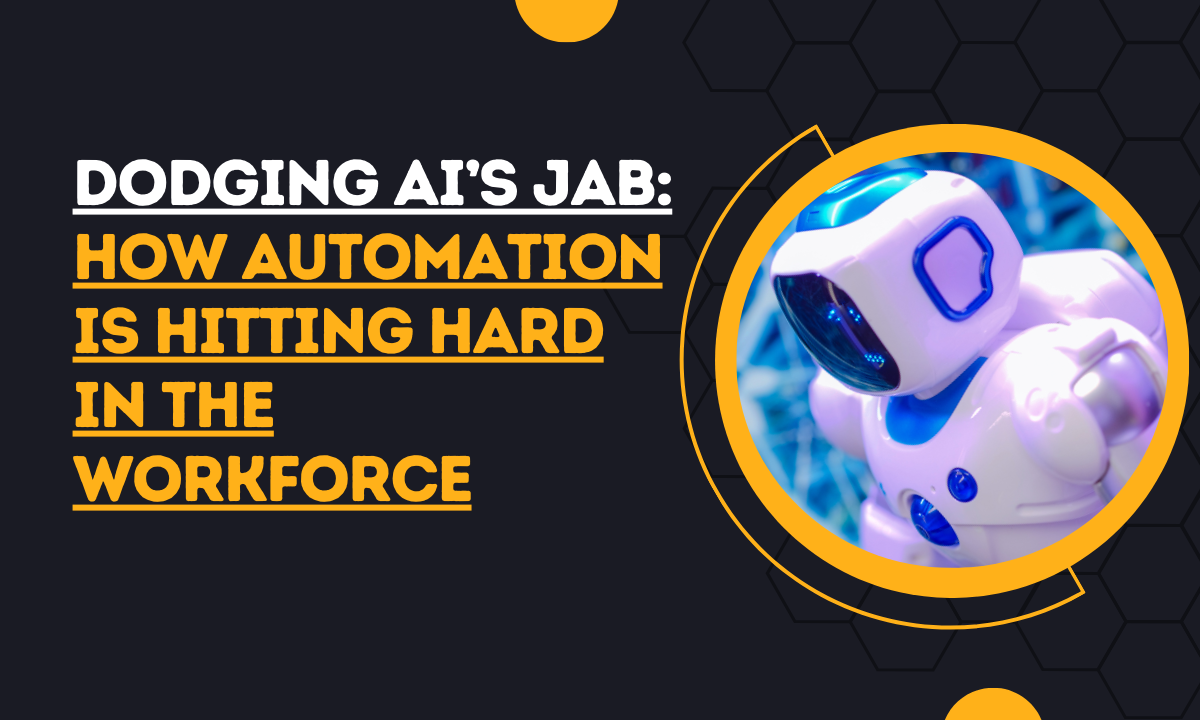Dodging AI’s Jab: How the Impact of AI is Hitting the Workforce
The impact of AI on jobs is one of the most pressing issues in today’s rapidly evolving workforce. As automation technologies like artificial intelligence continue to advance, they are reshaping industries and redefining what work looks like across the globe.
While AI has the potential to create new job opportunities, it is also displacing traditional roles in sectors such as manufacturing, retail, and customer service.
According to a recent report by the U.S. Bureau of Labor Statistics, automation is expected to affect millions of jobs in the coming decade, as machines increasingly take over routine tasks that were once done by humans
As per Pepelwerk blog. Artificial intelligence (AI) is set to profoundly affect job roles in 2024. As technological advancements continue, many tasks and processes previously handled by humans will be automated, driving significant changes in job responsibilities and requirements.
The Current Jab: Jobs Most Impacted by AI and Automation
Automation is hitting various sectors hard, with some roles seeing significant declines.
According to a 2023 report by McKinsey & Company, up to 30% of the hours worked globally could be automated by 2030 due to advancements in artificial intelligence and robotics.
Industries such as manufacturing, retail, transportation, and finance have already seen substantial shifts.
For instance, cashier roles in retail are rapidly being replaced by self-checkout kiosks, and factory assembly jobs are being taken over by robotic arms that can work faster, longer, and without breaks.
In transportation, the rise of autonomous vehicles signals a major shift.
A study from the U.S. Bureau of Labor Statistics suggests that as many as 1.7 million truck-driving jobs are at risk in the U.S. alone due to self-driving truck technology.
These examples highlight the scope of change workers are facing—and why they’re feeling the pressure.
The Impact of AI on Jobs In Various Sectors
| Sector | Job Role Impacted | Description | Sources |
|---|---|---|---|
| Retail | Cashiers | Self-checkout kiosks replacing cashier positions in many stores. | McKinsey & Company, U.S. Bureau of Labor StatisticsBureau of Labor Statistics |
| Manufacturing | Assembly Line Workers | Robotic arms and machines replacing manual assembly tasks. | McKinsey & Company, Bureau of Labor StatisticsBureau of Labor Statistics |
| Transportation | Truck Drivers | Autonomous vehicles (self-driving trucks) replacing human drivers. | U.S. Bureau of Labor StatisticsBureau of Labor Statistics |
| Finance | Bank Tellers & Loan Officers | AI-driven automation of routine banking functions, such as customer service. | McKinsey & CompanyBureau of Labor Statistics |
| Customer Service | Call Center Representatives | AI-powered chatbots and virtual assistants handling customer inquiries. | McKinsey & Company, World Economic ForumBureau of Labor Statistics |
| Healthcare | Medical Imaging Technicians | AI used for analyzing medical images, reducing the need for human technicians. | World Economic Forumpepelwerk blog |
| Logistics | Warehouse Workers | Automation and robotics in warehouses and supply chain management. | U.S. Bureau of Labor StatisticsBureau of Labor Statistics |
| Hospitality | Hotel Clerks & Receptionists | AI tools like chatbots and automated check-in systems replacing human staff. | McKinsey & CompanyBureau of Labor Statistics |
Why AI and Automation Are No Longer Just ‘Future Threats’
Not too long ago, automation was a distant prospect for many roles, but rapid developments in machine learning have brought it into the present.
Today’s AI systems can handle complex tasks, from data analysis to customer service, often more efficiently than humans.
As technology analyst Andrew Yang puts it, “Automation is relentless, and its effects on the labor market will only become more pronounced as time goes on.”

Examples of this relentless pace include robotic process automation (RPA) in finance, which allows AI to manage repetitive tasks like data entry and report generation.
Even customer service roles, once reliant on human interaction, are increasingly managed by advanced chatbots that can respond instantly and handle multiple customers at once.
These developments show that automation is not just around the corner—it’s here, and it’s transforming work environments.
“Dodging the Jab”: How Workers Are Attempting to Reduce the Impact of AI on Jobs
Online platforms like Coursera and edX have seen a sharp rise in enrollments for digital skills courses. In 2020, Coursera alone experienced a 640% increase in tech course enrollments.
The workforce is shifting towards “human-centered” roles, which machines find harder to replace. These include roles that require creativity, complex problem-solving, and emotional intelligence.
However, the transition isn’t easy for all workers, especially those with lower education levels or those nearing retirement
The Economic Body Blow: Wages, Wealth Inequality, and the Shrinking Middle Class
The impact of automation on wages and wealth inequality cannot be ignored. The impact of AI on jobs often leads to wage stagnation.
This is because fewer entry-level jobs exist to support workers starting their careers or displaced by technology.
Additionally, the profits from increased automation largely benefit executives and tech developers, exacerbating wealth inequality.
The concentration of wealth at the top raises concerns about the erosion of the middle class, as fewer people have access to well-paying, stable jobs.
As Bill Gates aptly warned, “If people have no jobs, they have no money to buy goods. And the wheels of the economy grind to a halt.” The looming question is whether our current economic models can handle these changes or if we need new approaches to maintain stability.
Can We Deflect the Blow? Potential Solutions for a Sustainable Workforce
Universal basic income (UBI) trials in Finland and California have shown improvements in life quality and economic stability.
The Economic Security Project advocates for UBI, stressing the need for new solutions in an era of rising automation.
Essentially Universal Basic Income (UBI) proposes regular, unconditional payments to all citizens, aiming to support those displaced by automation. This system seeks to ensure financial stability as traditional jobs become less available.

Additionally, public policies supporting job transition programs are crucial. For instance, Germany has invested in re-skilling workers in manufacturing and coal mining, easing economic transitions.
What the Future Holds: Is Total Automation Inevitable?
Experts disagree on whether humans will always be needed for creative and strategic roles, or if automation will dominate.
Some believe automation will eventually transform nearly every industry.
As automation grows, society may need to redefine productivity, purpose, and fulfillment in the face of fewer traditional jobs.
Eventually, reimagining work could be essential to finding new ways for people to contribute value and meaning in their lives.
FAQs
1. What is the primary purpose of automation and AI in the workforce?
- Automation and AI are designed to perform repetitive, labor-intensive, or complex tasks more efficiently than humans. The goal is to increase productivity, reduce costs, and improve accuracy in various industries, from manufacturing to customer service.
2. Which jobs are most affected by AI and automation?
- Jobs in sectors like manufacturing, retail, transportation, finance, and data entry are among the most affected. Tasks that are highly repetitive, rule-based, and predictable are more susceptible to being automated.
3. Is total job loss due to automation inevitable?
- Not entirely. While automation can displace certain jobs, it can also create new roles that require skills in managing, developing, or troubleshooting AI technologies. Additionally, “human-centered” roles requiring creativity, empathy, and complex problem-solving are likely to remain valuable.
4. What’s the impact of AI on jobs in terms of wage inequality?
- Automation tends to concentrate wealth among company owners and technology developers, often leading to wage stagnation for displaced workers. This contributes to widening income inequality as profits increase but are not distributed evenly across the workforce.
5. What is universal basic income (UBI), and how could it help?
- UBI is a system where all citizens receive a regular, unconditional sum of money from the government. It’s proposed as a way to support those displaced by automation, helping ensure financial security and economic stability as traditional jobs become scarce.
6. Are there any real-world examples of successful automation adaptation?
- Yes, Germany has implemented successful re-skilling programs for workers in industries affected by automation, like manufacturing and coal mining. These programs help displaced workers transition into new roles, providing a possible model for other nations.
7. How can workers protect themselves from the impact of AI on jobs?
- By investing in education and skill development, particularly in fields like technology, data science, and soft skills like communication and problem-solving. Continuous learning and adaptability are key to staying relevant as the job market evolves.
8. Why is there resistance to automation despite its potential benefits?
- While automation can lead to increased efficiency and lower costs, there’s concern over job displacement, income inequality, and reduced economic security. Additionally, there are worries about the societal impact of reduced human labor and the need for changes in economic policies.
9. How does automation affect small businesses and entrepreneurs?
- Automation can be a double-edged sword for small businesses. On one hand, it allows them to operate more efficiently with fewer employees; on the other hand, small businesses may lack the resources to fully automate and compete with larger companies that can.
10. What does the future of work look like with increased automation?
- The future of work may include fewer traditional jobs and more roles that focus on managing or collaborating with AI. We may also see a shift towards creative and interpersonal roles. Society may need to rethink economic models to address these changes, potentially moving toward systems like UBI or redefining the concept of work and productivity.
Related Posts
The Power of AI Content: Transforming the Digital World
Skyrocket Your Reach with AI-Driven Search Optimization!
AI-Generated Content: Trustworthy Innovation or Digital Deception?
AI in Content Creation: The Future Revolution in Blogging
Conclusion
The impact of AI on jobs is transforming the workforce, challenging workers to adapt and raising concerns about economic stability. While some reskill to “dodge” the impact, automation’s structural changes demand bold solutions.
Universal basic income and government programs may help ensure automation benefits society instead of destabilizing it.
As we step into this era, proactive measures will be crucial in balancing technological progress with workforce well-being.

